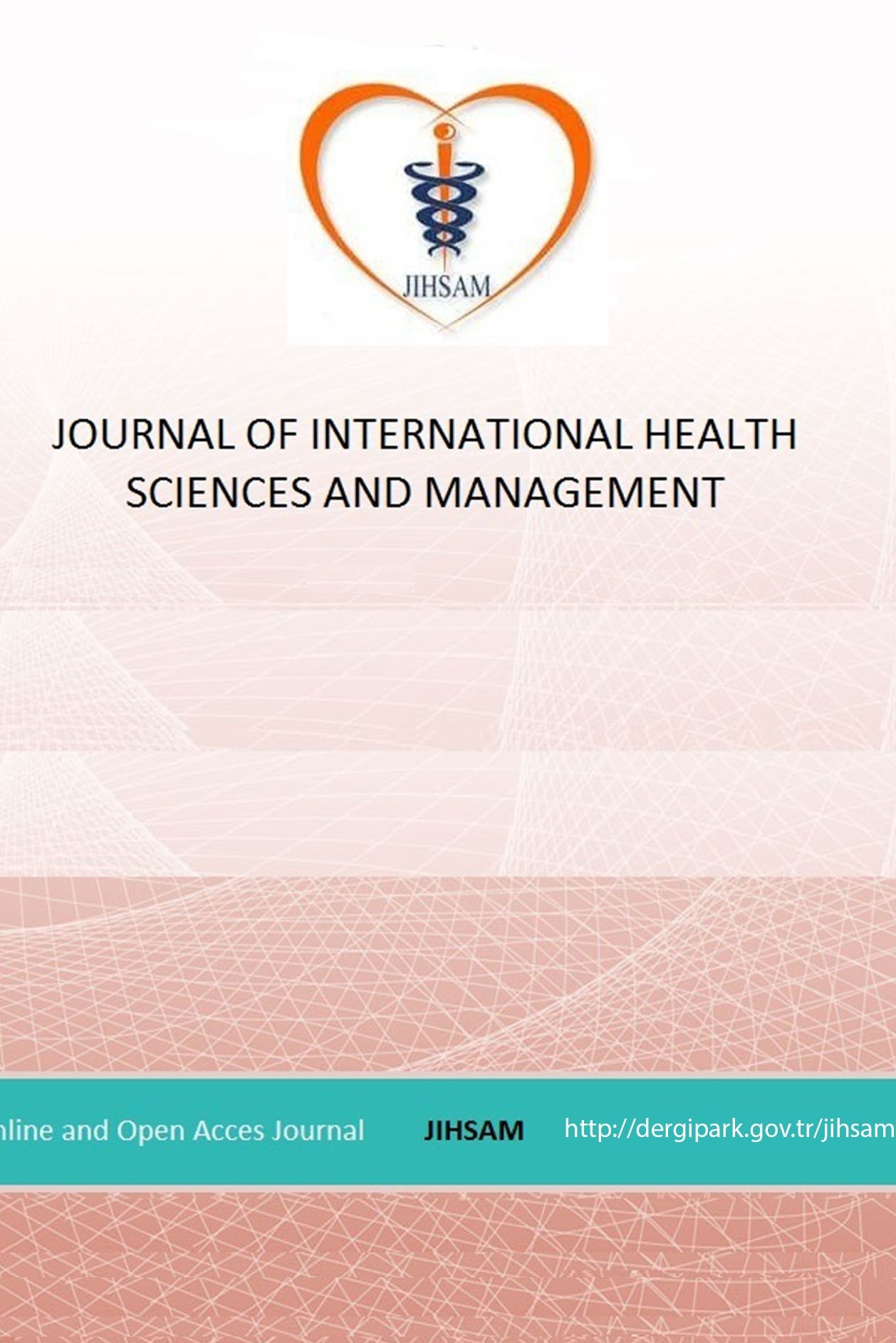EVALUATION OF HEALTHY LIFESTYLE BEHAVIORS OF UNIVERSITY STUDENTS
EVALUATION OF HEALTHY LIFESTYLE BEHAVIORS OF UNIVERSITY STUDENTS
Health Behavior, Healthy Lifestyle Behaviours,
___
- Altunışık R, Coşkun R, Bayraktaroğlu S, Yıldırım E. (2012). Sosyal Bilimlerde Araştırma Yöntemleri SPSS Uygulamalı, Sakarya, Sakarya Yayıncılık.
- Arslan C, Ceviz D. (2007). Ev Hanımı ve Çalışan Kadınların ObezitePrevelansı ve Sağlıklı Yaşam Biçimi Davranışlarının Değerlendirilmesi. Fırat Üniversitesi Sağlık Bilimleri Dergisi.21 (5): 211 – 220
- Baltaş Z. (2007). Sağlık psikolojisi: halk sağlığında davranış bilimleri. 2.bs. İstanbul: Remzi Kitabevi.
- Bahar Z, Beser A, Gördes N, Ersin F, Kıssal A. Sağlıklı Yaşam Biçimi Davranışları Ölçeği II’nin Geçerlik ve Güvenirlik Çalısması, C.Ü.Hemsirelik Yüksekokulu Dergisi 2008;12:1-13.
- Büyüköztürk Ş, Kılıç Çakmak E, Akgün ÖE, Karadeniz Ş, Demirel F. (2013). Bilimsel Araştırma Yöntemleri. Ankara, Pegem Akademi,
- Bozhüyük A. (2010). Çukurova Üniversitesi Sağlık Bilimleri Öğrencilerinin Sağlıklı Yaşam Biçimi Davranışlarının Değerlendirilmesi.Çukurova Üniversitesi Tıp Fakültesi Aile Hekimliği Anabilim Dalı, Uzmanlık Tezi, 112 sayfa, Adana, (Yrd.Doç.Dr. Sevgi Özcan).
- Çepni Açıkgöz S. (2010). Üniversite Öğrencilerinde Sağlıklı Yaşam Biçimi Davranışları ile Sağlık Kontrol Odağı ve Sağlık Öz Yeterliği İlişkisi, Gazi Üniversitesi Sağlık Bilimleri Enstitüsü, Hemşirelik Programı, Yüksek Lisans Tezi, Ankara.
- Kasapoğlu S.E. (2015). Meslek Yüksekokulu Öğrencilerinin Sağlıklı Yaşam Biçimi Davranışlarının Değerlendirilmesi, Bülent Ecevit Üniversitesi Sağlık Bilimleri Enstitüsü, Halk Sağlığı Anabilim Dalı, Yüksek Lisans Tezi, Zonguldak.
- Kıray Vural B. (1998). Sağlık Riskinin Belirlenmesi ve Hemşirelik için Önemi. C.Ü. Hemşirelik Yüksekokulu Dergisi. 2(2):39-43.
- Özkan,S. ve Yılmaz,E.(2006);’’Hastanede Çalışan Hemşirelerin Sağlıklı Yaşam Biçimi Davraışları’’,Ulusal Cerrahi Kongresi Kongre Kitabı,24-28 Mayıs,Antalya
- Pender, N. Barkauskas, V. (1992). HealthPromotionandDiseasePreventionTowardExelence in NursingPracticeandEducation. Nursing Outlook; 40(3), 278-290.
- Spellbring A.M. (1991). Nursing’s Role in Health Promotion : An Overwiew. Nursing Clinic North of America, 26(4), 805-813
- Walker, N. W.,Madeleine, J. K., Pender, N. J. (1990). A Spanish Language Version of the HealthPromotingLifestyle Profile. NursingResearch, 39 (5), 2-4
- Yıldırım N. (2005). Üniversite Öğrencilerinin Bazı Sosyo-Demografik Özelliklerinin Sağlıklı Yaşam Biçimi Davranışlarına Etkisi, Cumhuriyet Üniversitesi Sağlık Bilimleri Enstitüsü, Hemşirelik Programı, Yüksek Lisans Tezi, Sivas.
- Zaybak A, Fadıloğlu Ç. (2004). Üniversite öğrencilerinin sağlığı geliştirme davranışı ve bu davranışı etkileyen etmenlerin belirlenmesi. Ege Üniv Hemşire YO Derg, 20 (1):77-95.
- Yayın Aralığı: Yılda 2 Sayı
- Başlangıç: 2015
- Yayıncı: Sedat BOSTAN
HOSPICE-PALLIATIVE CARE INTERNATIONAL ORGANIZATIONS AND COUNTRIES
Çiğdem Müge HAYLI, Emrah FELEK
BENEVOLENCE OR COMPETENCE WHICH IS MORE IMPORTANT FOR PATIENT LOYALTY?
Mahmut AKBOLAT, Mustafa AMARAT, Özgün ÜNAL, Elif Saba SÜTLÜ
EXAMINING FACTORS THAT HAVE AN IMPACT ON HOSPITAL PREFERENCES OF UNIVERSITY STAFF
Aynur TORAMAN, Dilek KOCABAŞ, Ramazan ERDEM
PERFORMANCE ANALYSIS OF OECD COUNTRIES BASED ON HEALTH OUTCOMES AND EXPENDITURE INDICATORS
İsa GÜL, Aysun YEŞİLTAŞ, Sibel ŞAHİN
EVALUATION OF HEALTHY LIFESTYLE BEHAVIORS OF UNIVERSITY STUDENTS
Yunus Emre ÖZTÜRK, Ramazan KIRAÇ
FUTURIST STUDY ABOUT THE FUTURE OF HEALTH SECTOR
Ramazan ERDEM, Dilruba UĞURLUOĞLU
THE IMPACT OF THE PATERNALIST LEADERSHIP ON ORGANIZATIONAL CYNICISM: A RESEARCH IN THE HEALTH SECTOR
HOW DOES FATIGUE IN INDIVIDUALS WITH CHRONIC OBSTRUCTIVE PULMONARY DISEASE EFFECT DEPENDENCY STATUS
